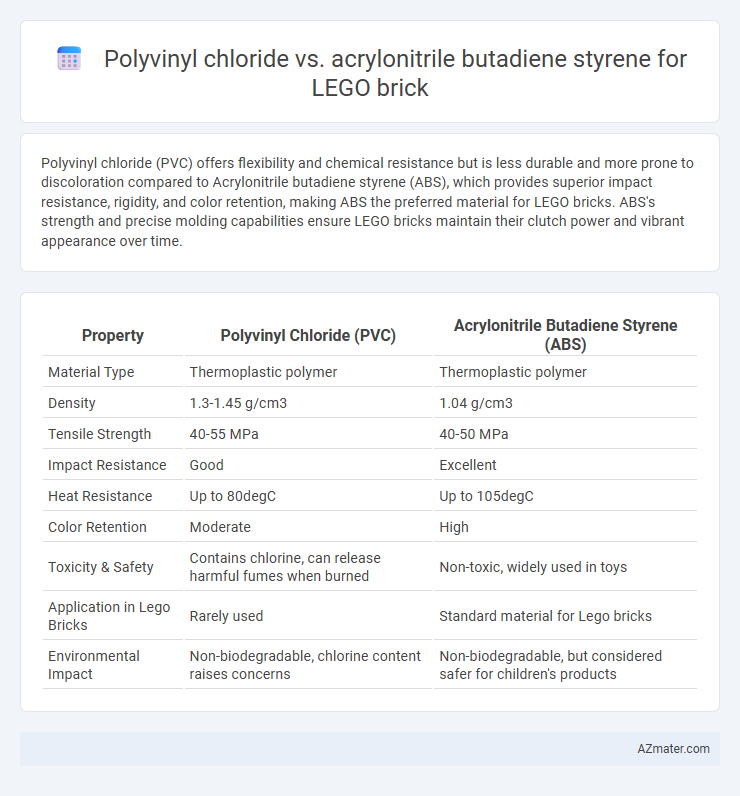Polyvinyl chloride (PVC) offers flexibility and chemical resistance but is less durable and more prone to discoloration compared to Acrylonitrile butadiene styrene (ABS), which provides superior impact resistance, rigidity, and color retention, making ABS the preferred material for LEGO bricks. ABS's strength and precise molding capabilities ensure LEGO bricks maintain their clutch power and vibrant appearance over time.
Table of Comparison
| Property | Polyvinyl Chloride (PVC) | Acrylonitrile Butadiene Styrene (ABS) |
|---|---|---|
| Material Type | Thermoplastic polymer | Thermoplastic polymer |
| Density | 1.3-1.45 g/cm3 | 1.04 g/cm3 |
| Tensile Strength | 40-55 MPa | 40-50 MPa |
| Impact Resistance | Good | Excellent |
| Heat Resistance | Up to 80degC | Up to 105degC |
| Color Retention | Moderate | High |
| Toxicity & Safety | Contains chlorine, can release harmful fumes when burned | Non-toxic, widely used in toys |
| Application in Lego Bricks | Rarely used | Standard material for Lego bricks |
| Environmental Impact | Non-biodegradable, chlorine content raises concerns | Non-biodegradable, but considered safer for children's products |
Introduction to LEGO Brick Materials
Polyvinyl chloride (PVC) and acrylonitrile butadiene styrene (ABS) are two prominent materials used in the manufacturing of LEGO bricks, each offering distinct properties affecting durability and safety. ABS is widely favored for LEGO bricks due to its excellent impact resistance, high tensile strength, and superior color retention, ensuring long-lasting, vibrant pieces. PVC, while more flexible and cheaper, is less commonly used in LEGO bricks due to concerns over chemical stability and less optimal mechanical properties compared to ABS.
Overview of Polyvinyl Chloride (PVC)
Polyvinyl chloride (PVC) is a versatile thermoplastic polymer known for its durability, chemical resistance, and ease of molding, making it a common choice in various manufacturing applications. In contrast to acrylonitrile butadiene styrene (ABS), PVC offers enhanced flexibility and resistance to environmental factors such as moisture and UV exposure. However, PVC's lower impact resistance and potential release of harmful chemicals during processing generally make ABS the preferred material for high-quality, safe, and rigid Lego bricks.
Acrylonitrile Butadiene Styrene (ABS) Explained
Acrylonitrile butadiene styrene (ABS) is the preferred material for LEGO bricks due to its excellent impact resistance, toughness, and ability to maintain vibrant colors without fading. ABS offers superior dimensional stability and a smooth, glossy finish, ensuring the bricks fit together precisely and maintain their shape over time. Unlike polyvinyl chloride (PVC), ABS is less prone to deformation and provides greater safety and durability in children's toys.
Mechanical Properties: PVC vs ABS
Polyvinyl chloride (PVC) offers higher flexibility and impact resistance compared to Acrylonitrile butadiene styrene (ABS), making it more suitable for applications requiring durability under bending stresses. ABS exhibits superior stiffness and dimensional stability, ensuring precise interlocking in LEGO bricks and maintaining structural integrity during repeated assembly and disassembly. Mechanical properties data show PVC has a tensile strength of approximately 34 MPa, while ABS reaches around 40 MPa, highlighting ABS's advantage in rigidity critical for LEGO construction performance.
Durability and Longevity Comparison
Polyvinyl chloride (PVC) offers excellent durability with high chemical resistance and flexibility, making it less prone to cracking under stress compared to Acrylonitrile Butadiene Styrene (ABS), which is known for its superior rigidity and impact resistance. ABS provides greater longevity for Lego bricks through enhanced resistance to physical wear, maintaining color and structural integrity even after extensive use. Both materials contribute to Lego's durability standards; however, ABS remains the preferred choice for its balance of toughness and long-term performance in toy manufacturing.
Safety and Non-Toxicity for Children
Polyvinyl chloride (PVC) and Acrylonitrile butadiene styrene (ABS) are both used in Lego bricks, but ABS is preferred for safety and non-toxicity in children's toys. ABS is non-toxic, odorless, and meets strict international safety standards, minimizing risks of harmful chemical exposure. PVC may contain phthalates and other additives that pose potential health concerns, making ABS the safer choice for children's play materials.
Color and Aesthetic Quality Differences
Polyvinyl chloride (PVC) offers superior color retention and a wider range of vibrant hues compared to Acrylonitrile butadiene styrene (ABS), making it ideal for Lego bricks requiring intense and lasting color vibrancy. ABS provides a glossier finish with excellent surface smoothness, enhancing the aesthetic appeal of Lego bricks through its high-quality sheen and uniform texture. PVC's ability to maintain color stability under exposure to light and heat contrasts with ABS, which can experience slight discoloration over time, impacting long-term visual consistency.
Environmental Impact and Recyclability
Polyvinyl chloride (PVC) poses significant environmental challenges due to toxic chlorine content and difficulties in recycling, leading to hazardous byproducts during disposal. Acrylonitrile butadiene styrene (ABS) offers superior recyclability and generates fewer toxic emissions, making it a more sustainable choice for Lego bricks. ABS's durability and ease of recycling contribute to reducing environmental impact, aligning with modern eco-friendly manufacturing standards.
Manufacturing Process and Cost Analysis
Polyvinyl chloride (PVC) offers greater flexibility in molding Lego bricks through its plasticizer additives but involves higher material and processing costs due to the need for stabilizers and careful handling during extrusion. Acrylonitrile butadiene styrene (ABS), the traditional choice for Lego, provides superior toughness and dimensional stability with an injection molding process that is more cost-efficient and faster, making it ideal for high-volume production. Overall, ABS balances performance and manufacturability with lower production expenses, whereas PVC incurs increased costs and complexity despite its adaptable properties.
Conclusion: Best Material Choice for LEGO Bricks
Polyvinyl chloride (PVC) offers excellent durability, chemical resistance, and color retention, making it a strong candidate for LEGO bricks but raises concerns due to its environmental impact and potential health hazards. Acrylonitrile butadiene styrene (ABS) provides superior impact resistance, ease of molding, and is widely favored for its eco-friendliness and recyclability in toy manufacturing. ABS stands out as the best material choice for LEGO bricks, combining safety, performance, and sustainability essential for high-quality construction toys.

Infographic: Polyvinyl chloride vs Acrylonitrile butadiene styrene for Lego brick
 azmater.com
azmater.com